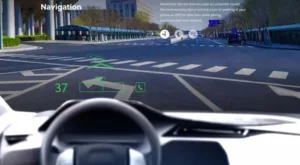Over a year ago we reported on WayRay, a Swiss start up company that was working on an aftermarket holographic HUD that would change the way future cars would be using head up displays. (WayRay Announces Holographic Head Up Display for Later This Year). The technology description was a little light on the explanation of why this was described as a holographic display, but it basically described an augmented reality HUD (AR-HUD). Now, a year later, they are advertising some products, Element, an OBD II-based scanner that provides info to an app on your smartphone and Navion, an aftermarket HUD that includes augmented reality and uses the Element OBD connection. For now, this is still just a product announcement with no way to buy actual products via the website.
WayRay AR HUD
It would seem that there should be no reason to mention them again until they actually have a product to sell. However, a recent article “Augmented reality’s future isn’t glasses. It’s the car” written by Vitaly Ponomarev, WayRay published by Venture Beat argues that the future of AR does not lie with mobile devices but with the car. There are a few arguments used in the article that try to suggest that AR will have a great future in cars long before it will reach consumers on mobile devices such as glasses. Here are the key arguments used in the article:
- Tablets and smartphones have not reached the performance level needed to provide good AR
- The small form factor makes it difficult to reach the necessary performance level anytime soon (see VR and AR Head Mounted Displays – Sorry, but there is no Santa Claus)
- Changes within the automotive industry are driving enhanced HUD applications in the car
- New forms of social platforms for drivers that allow the exchange of data by the drivers in the close by environment are developing
- Self driving cars will open a platform for AR HUDs to keep control of what is going on while the computer is driving the car
- Glasses-based AR is quite some time away as the form factor makes it very difficult to achieve high performance AR
- Smartphones and tablets are still essential to develop the AR infrastructure
Analyst Comment
While some of the arguments are actually quite understandable, I cannot subscribe to the idea suggested by the author and WayRay. For one, they have a very personal interest in this view as the developer of automotive AR HUD solutions. Second, so far they have not be able to manufacturer a device that can provide the quality they say is so much easier to achieve in cars than it is in glasses and smartphones.
However, I have to admit that they are making one convincing argument; cars should have it much easier to develop a better HUD compared to a glasses-based system. They have more or less unlimited power, they have more space and the driver is sitting in a well defined space. Cameras can be installed in the car to view the driver as well as the surroundings. Available space and power allow the use of much higher powered computers to provide a better AR environment than mobile devices can.
So why do we not already have an AR HUD installed in at least top end cars?
This is where real life meets wth good ideas. The automotive industry is a very competitive one with long established brands fighting for market share. So far their success was based on providing a better product than their competitor. As we can witness from engines, human machine interfaces, and used display technology, the car industry is slow to adopt new technology and has to provide support for this technology long after the technology has already moved on. If you own a 10 year old car and your infotainment display breaks down you expect to go to the dealer an have a new one installed. Would you even bother to do the same with a 10 year old smartphone?
There is a significant difference in the lifetime expectancy of cars and consumer electronics. One is short lived and other on has a significant life span*. When you combine this with manufacturer’s drive to differentiate car brands by technology you can appreciate the hesitance to jump on the latest technology bandwagon. Look at the adoption of HUDs, this is going on for quite some time. This does not mean that the leading car companies are not trying to develop AR HUDs, they all do and they all want the solution that is better than their competitors and gives them an edge. Cooperation is not something that is very common in the automotive world. This is like iOS and Android with the exception that there are more than ten brands fighting for market leadership.
While cars have a technology advantage over mobile AR solutions, the market forces in the automotive industry are a barrier for adoption. The question is what can be overcome more easily technology challenges in the mobile sector or market forces in the automotive market. We will see. (NH)
* On the other hand, if we assume a design life of 100,000 miles and an average speed of 20mph, the design life of a car is just 5,000 hours, with typically 10 services over that period. That’s not a long time to those in the display industry that talk about 20,000, 50,000 or 100,000 hours of life. However, as Norbert points out, these 5,000 hours will be over ten years or more. On the basis that “if it ain’t broke, don’t fix it”, and because she drives only low mileage, my wife has just replaced her car after 14 years – making it 17 years old. It would be interesting to talk to an IT company or CE company about a 17 year old product and getting spares or service! (BR)

